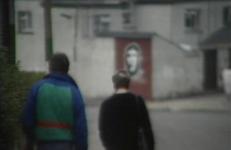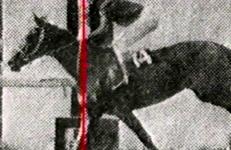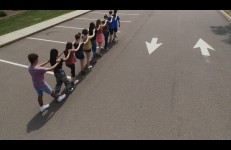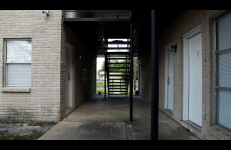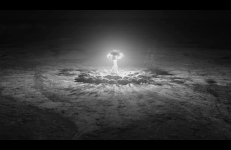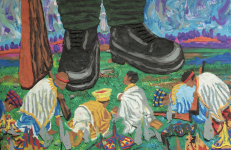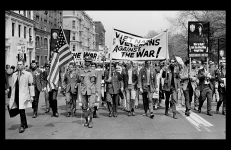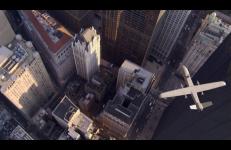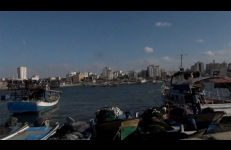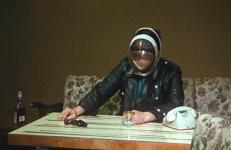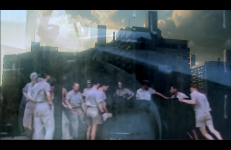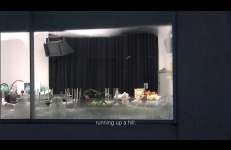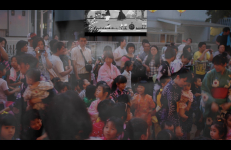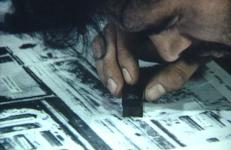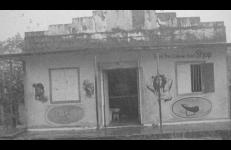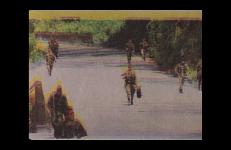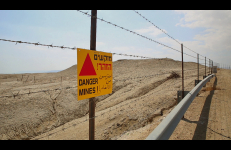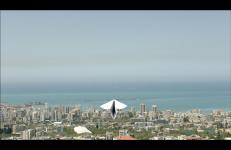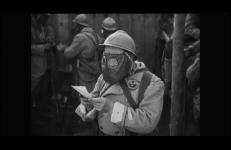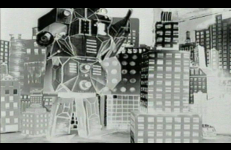This video takes its departure from the BBC's coverage of the killing of three IRA volunteers by British Security Forces in Strabane, a small town on the border between Northern Ireland and the Irish Republic. Interrogating television discourse, the video examines what is referred to as the British “shoot to kill” policy of planned assassination in the North.
War
Though difficult at times to understand what is happening due to audio damage, this tape provides rich historical documentation of a protest on Wall Street in May of 1971. The tape also records the energy in the air created by motivated activists who took to the streets at Columbia University in protest of the Vietnam War.
—Faye Gleisser
This piece investigates the possibilities and limits of writing a history of the Lebanese civil wars (1975-1991). The videos offer accounts of the fantastic situations that beset a number of individuals, though they do not document what happened. Rather, they explore what can be imagined, what can be said, what can be taken for granted, what can appear as rational, sayable, and thinkable about the wars.
This film uses the ‘old fashioned’ conventions of documentary film practice to stand history on its head. There is a narration taken from a radio lecture by Claude Lévi-Strauss entitled, “The Meeting of Myth and Science,” images from the Deutsche Wochenshau of June 25, 1940 that recorded Hitler’s dawn visit to Paris, images from American newsreels, a movement from one of Beethoven’s Rasumovsky Quartets. The film could only succeed, in my mind, if the imprint of prior usage of all elements was clear.
Drills is a film about the choreography of preparing for the future. A hybrid documentary and experimental dance film reimagining the form of the Cold War-era, US government-produced social guidance film, Drills asks what futures we are preparing for through the exercises embodying present anxieties. Weaving in between multiple forms of choreography and documentation, Drills restages lockdown and active shooter drills, frames corporate and tech start-up office meditation, and reperforms Boy Scout drills from the 1917 Boy Scout manual.
From below ground, a man named Eddie describes flood lines, levees and trivial histories of the crumbling infrastructure of Memphis, TN. In this same city, the filmmaker, a recent transsexual transplant, watches military propaganda and contemplates masculine connectivity as he attempts to integrate into the American South. He posts a Craigslist ad asking men to masturbate on-camera with their firearms. He receives a single response from a man whose name is also Eddie.
Inspired by an unaccomplished personal project, in this animation, I’m exploring ideas of intention, extension, and failed romanticism. I used images and texts from mass-produced postcards, packaging, calendar booklets, books, posters, and pamphlets that were created and used as political propaganda devices for the invasion of Ethiopia by Fascist Italy during WWII. Some of these prints were on the front covers of school notebooks, some were games that taught the geography, history, and natural resources of Ethiopia.
A film for high school students and their teachers about the history of the Viet Nam War, composed of just photographs from that war, narration and, to help us through a damned disheartening story, lots of the Bach Suite for Solo Cello #1 in G.
To read the accompanying curriculum guide click here.
Unmanned Aerial Vehicles — drones — have become an everyday feature of contemporary military activity, replacing humans in reconnaissance flights, small-scale combat missions and covert operations. The U.S. Army operates some ten thousands UAVs — a six-fold increase during Obama's term — deploying them over locations like Pakistan and Yemen.
Home Movies Gaza introduces us to the Gaza Strip as a mircrocosm for the failure of civilization. In an attempt to describe the everyday of a place that struggles for the most basic of human rights, this video claims a perspective from within the domestic spaces of a territory that is complicated, derelict, and altogether impossible to separate from its political identity.
"... Basma Alsharif’s Home Movies Gaza, a film that captures the impossibly politicized domestic sphere of the Gaza Strip, under the constant hum and buzz of overhead drones."
Hostage: The Bachar Tapes (English Version) is an experimental documentary about "The Western Hostage Crisis." The crisis refers to the abduction and detention of Westerners like Terry Anderson, and Terry Waite in Lebanon in the 80s and early 90s by "Islamic militants." This episode directly and indirectly consumed Lebanese, U.S., French, and British political and public life, and precipitated a number of high-profile political scandals like the Iran-Contra affair in the U.S.
Hostage: The Bachar Tapes (English Version) is an experimental documentary about "The Western Hostage Crisis." The crisis refers to the abduction and detention of Westerners like Terry Anderson, and Terry Waite in Lebanon in the 80s and early 90s by "Islamic militants." This episode directly and indirectly consumed Lebanese, U.S., French, and British political and public life, and precipitated a number of high-profile political scandals like the Iran-Contra affair in the U.S.
The author assembles a genre picture of the contemporary FRG with shots of scenes where life is rehearsed, ability/durability is tested. Wherever one looks, people appear as actors playing themselves; they take on roles. A play in the theater of life made up of training courses, fitness tests for things and people. Be it in birth preparation classes for expectant parents or in practice runs for sales talks, on the military training ground or during role-plays for educational purposes. Everywhere the incessant effort to be prepared for the emergency of "reality" can be felt.
In an interview I did earlier this year for the Milan Game Video/Art exhibition, I deflected a question about the connection between Hymn of Reckoning and Reckoning 3, discouraging the idea that there was much of a link between the two videos, apart from their names and their use of video game material. Now that I’ve thought about it more, I can tease out more connections.
I Was There is a trilogy of experimental documentary films that explores the problem of radiation, our society's fading collective memory of the atomic bombing of Hiroshima and Nagasaki, and the unresolved debate between ethics and science. These series concern the immediate effects of weaponized nuclear technology, as invisible poison, on the human body.
Newly uncovered 16mm footage from US Army archives recorded the bare land of Hiroshima and the questions of war tactics on the human race immersed in the present time. I Was There is a trilogy of experimental documentary films that explores the problem of radiation, our society's fading collective memory of the atomic bombing and the unresolved debate between ethics and science.
The film reexamines J. Robert Oppenheimer's speech at Princeton Theological Seminary in 1958. I Was There is a trilogy of experimental documentary films that explores the problem of radiation, our society's fading collective memory of the atomic bombing of Hiroshima and Nagasaki, and the unresolved debate between ethics and science. These series concern the immediate effects of weaponized nuclear technology, as invisible poison, on the human body.
The vanishing point of Images of The World is the conceptual image of the 'blind spot' of the evaluators of aerial footage of the IG Farben industrial plant taken by the Americans in 1944. Commentaries and notes on the photographs show that it was only decades later that the CIA noticed what the Allies hadn't wanted to see: that the Auschwitz concentration camp is depicted next to the industrial bombing target.
For over 70 years, Colombia has been confronted with internal armed conflict. Over the years, the outlines of the conflict have grown indistinct. A climate of generalized violence has gradually settled over society as a whole.
Violence and barbarity have worked themselves into every aspect of daily life, and fine traces of it mark the streets. Through a multitude of these traces, perhaps the narrative of this hazy war will finally take a firmer shape.
A series of unnatural deaths and departures (almost all, of men) disrupts the lives of nine families sharing an apartment building in Jerusalem.
Zaatari’s contribution to Lebanon’s Pavilion at the Venice Biennial 2013. This video offers a portrait of a public school and a tribute to those refusing illegal military orders.
Part of paraconsistent sequence series and the hauntology series.
¡Macho Shogun! was created by Reed Anderson and Daniel Davidson over a single weekend some time in 2000. It's your basic monster-robot / destroy-city kind of video that we wanted to make when we were kids but never did.
This title is only available on Suitable Video, Volume 1.




